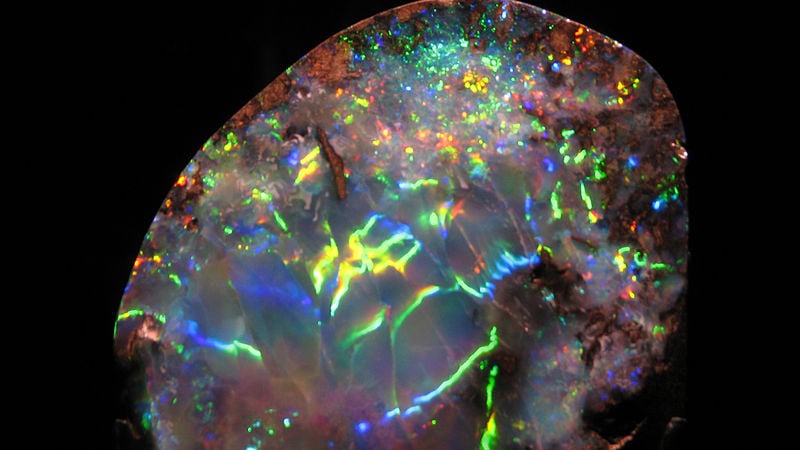Australian Opals
Australian opals account for 95% of the world’s supply. Learn about Australia’s geological history, the start of its opal trade, and its notable sources.
1 Minute Read
The Great Artesian Basin
The formation process began about 140 million years ago. At that time, an inland sea, abundant with silica-rich sands, covered much of central Australia. This sea eventually receded and formed what is now known as the Great Artesian Basin.
Around 30 to 40 million years ago, heavy weathering began to dissolve the silica. The holes that were formed in the rock began to collect silica-rich water. Over time, the silicates trapped in these spaces formed opals.
Interested in this topic?
This article is also a part of our Opal Specialist Mini Course, in the unit Introduction to Opals and Their Properties.
While the Great Artesian Basin is vast, there are only a few sites in this area that are sources of opal. (As any miner will tell you, good quality opal is rare even in the best of areas).
On the map to the right, you can find notable Australian opal fields both within and beyond the Great Artesian Basin.
The Beginning of the Australian Opal Trade
The modern history of opal mining in Australia began in July of 1889. Tullie Cornthwaite Wollaston took 60 brilliant pieces of opal rough mined in Queensland to London.
Despite initial rejections from gem dealers, after Wollaston sold the stones to an international jewelry firm, the demand for Australian opals grew steadily worldwide.
Select Sources of Australian Opals
Today, most black opal (stones with a dark gray to blue-black background) comes from Lightning Ridge, New South Wales and Mintabie, South Australia. The fields around Coober Pedy, South Australia also produce some black opal.
Coober Pedy and Mintabie are also rich sources of light and white opal (stones with a white or light background).
Boulder opal, a thin seam of precious opal on an ironstone matrix, is found at a number of locations in Queensland. Smaller finds also come from Andamooka, South Australia.
Yowah nuts, walnut-sized stones with opals in the center, are found in Yowah, Queensland.
Donald Clark, CSM IMG
Donald Clark, CSM founded the International Gem Society in 1998. Donald started in the gem and jewelry industry in 1976. He received his formal gemology training from the Gemological Institute of America (GIA) and the American Society of Gemcutters (ASG). The letters “CSM” after his name stood for Certified Supreme Master Gemcutter, a designation of Wykoff’s ASG which has often been referred to as the doctorate of gem cutting. The American Society of Gemcutters only had 54 people reach this level. Along with dozens of articles for leading trade magazines, Donald authored the book “Modern Faceting, the Easy Way.”
Related Articles
Opal Stones and Gems: Value, Price, and Jewelry Information
Mined in America: Top Spots for Gem Hunting in the US
Tips for Cabbing and Carving Opals
Identifying Opal Patterns
Latest Articles
800 Years of Mogok: A Celebration in Tenuous Times
What is the Average Gemstone Faceting Yield?
Pyroxmangite Value, Price, and Jewelry Information
How to Identify Emerald Simulants and Synthetics
Never Stop Learning
When you join the IGS community, you get trusted diamond & gemstone information when you need it.
Get Gemology Insights
Get started with the International Gem Society’s free guide to gemstone identification. Join our weekly newsletter & get a free copy of the Gem ID Checklist!
